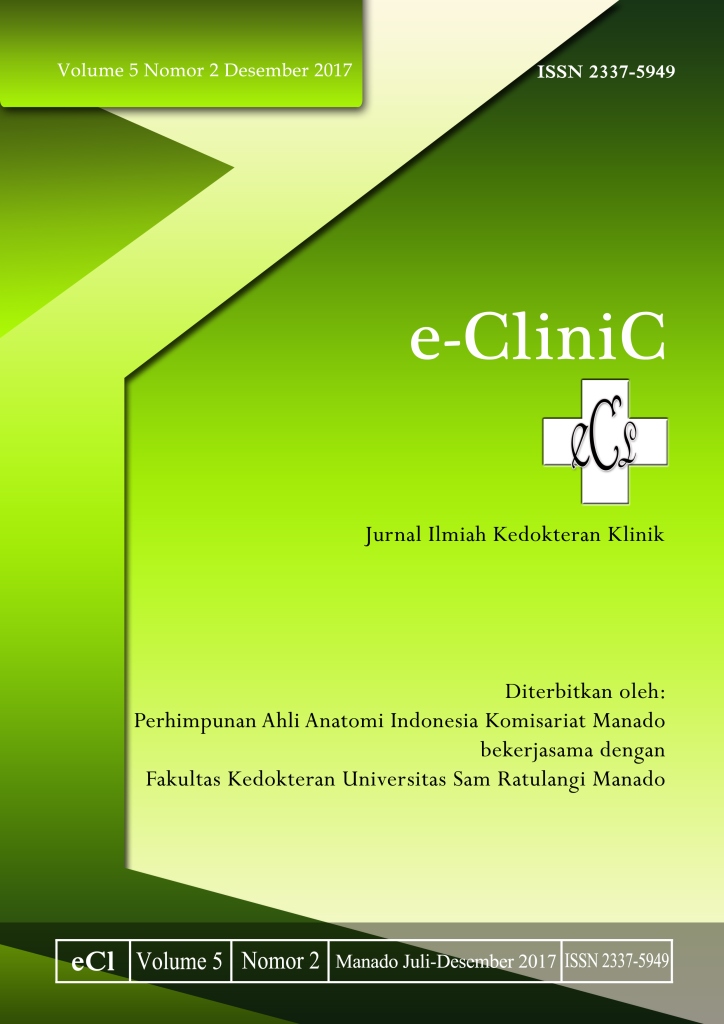Gambaran CT-Scan Tanpa Kontras pada Pasien dengan Batu Saluran Kemih di Bagian Radiologi FK Unsrat/SMF Radiologi RSUP Prof. Dr. R. D. Kandou Manado Periode Juli 2016 - Juni 2017
DOI:
https://doi.org/10.35790/ecl.v5i2.18765Abstract
Abstract: Urinary tract stone is the third most common disease after urinary tract infection and prostate cancer. Symptoms of urinary tract stones such as pain, hematuria, infection, fever, nausea, and vomiting appear when an obstruction occurs. To confirm the diagnosis of urinary tract stone, further examination can be performed such as radiology examination using CT-Scan which can provide a much better imaging compared to plain photo and ultrasonography. CT-scan is usually performed without contrast because the imaging of stone is clearly visible. This study was aimed to obtain the CT-scan imaging without contrast of patients with urinary tract stones in the Radiology Department of Faculty of Medicine Sam Ratulangi University/ SMF Radiology Prof. Dr. R. D. Kandou Hospital Manado in the period of July 2016 - June 2017. This was a descriptive retrospective study using patients’ medical records at the Radiology Department. The results showed that there were 190 patients suffering from urinary tract stones. The majority of cases were males (66.32%), age group of 48-57 years (30%), and had stones located in the renal region (67.38%). Conclusion: Based on the CT-Scan examination without contrast performed on patients with urinary tract stones, the prevalence of urinary tract stone was higher in males and the age group of 48-57 years with the most common location of the stones in the renal region.
Keywords: urinary tract stones, CT-Scan without contrast
Â
Abstrak: Batu saluran kemih merupakan penyakit tersering ketiga setelah infeksi saluran kemih dan kanker prostat. Gejala batu saluran kemih muncul ketika terjadi obstruksi berupa rasa nyeri, hematuria, infeksi, demam, mual dan muntah. Untuk menegakkan diagnosis dapat dilakukan pemeriksaan lanjutan seperti pemeriksaan radiologi dengan menggunakan CT-Scan yang dapat memberikan hasil pencitraan yang lebih baik dibandingkan foto konvensional dan ultrasonografi. Pemeriksaan CT-Scan biasanya tanpa menggunakan kontras karena gambaran batu sudah tampak dengan jelas. Penelitian ini bertujuan untuk mengetahui gambaran CT-Scan tanpa kontras pada pasien dengan batu saluran kemih di Bagian Radiologi FK Unsrat/SMF Radiologi RSUP Prof. Dr. R. D. Kandou Manado pada periode Juli 2016 - Juni 2017. Jenis penelitan ialah deskriptif retrospektif menggunakan data sekunder dari rekam medis pasien di Bagian Radiologi. Hasil penelitian mendapatkan sebanyak 190 pasien yang menderita batu saluran kemih dengan proporsi paling banyak pada laki-laki (66,32%), kelompok usia 48-57 tahun (30%), dan lokasi tersering pada daerah ginjal (67,38%). Simpulan: Berdasarkan hasil pemeriksaan CT-Scan tanpa kontras pada pasien batu saluran kemih didapatkan angka kejadian batu saluran kemih paling banyak pada laki-laki dan kelompok usia 48-57 tahun dengan lokasi tersering di daerah ginjal.
Kata kunci: Batu saluran kemih, CT-Scan tanpa kontras.
Downloads
How to Cite
Issue
Section
License
COPYRIGHT
Authors who publish with this journal agree to the following terms:
Authors hold their copyright and grant this journal the privilege of first publication, with the work simultaneously licensed under a Creative Commons Attribution License that permits others to impart the work with an acknowledgment of the work's origin and initial publication by this journal.
Authors can enter into separate or additional contractual arrangements for the non-exclusive distribution of the journal's published version of the work (for example, post it to an institutional repository or publish it in a book), with an acknowledgment of its underlying publication in this journal.
Authors are permitted and encouraged to post their work online (for example, in institutional repositories or on their website) as it can lead to productive exchanges, as well as earlier and greater citation of the published work (See The Effect of Open Access).







